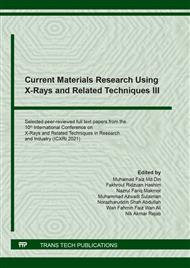p.33
p.39
p.49
p.54
p.62
p.68
p.74
p.80
p.86
Radiation Modification of Commercial Polyvinylidene Fluoride (PVDF) Backsheet Film for Mechanical and Thermal Properties Enhancement
Abstract:
Photovoltaic (PV) modules are supposed to be a reliable source of power for at least 25 years. Its component needs to work very efficiently to ensure electrical panels continue to perform. Backsheet film has been used to help insulating electrical components of PV modules to ensure PV can operate safely and protect them over their servicing life. PV modules are usually produced using encapsulated polymer such as polyvinylidene fluoride (PVDF), ethylene-vinyl acetate (EVA), polyamide (PA) or polyethylene terephthalate (PET). However, under continuous environmental stresses the components of solar panel including backsheet film are prone to malfunctions and failure after long term services. Thus, the service lifetime of PV systems may be shorter than the predicted lifetime. To overcome these issues, efforts have been made to enhance the performance of backsheet films by using radiation crosslinking method. The effects of electron-beam irradiation on mechanical and thermal properties for PVDF commercial backsheet film were studied. It was found that degree of crosslinking increased as irradiation dose increased. Irradiated PVDF has adequate mechanical properties to be used as backsheets for solar cells according to industrial reference. The result of SEM resulted in increased strength and stiffness of irradiated PVDF, which support the result of tensile test. In addition, the TGA analysis showed a good thermal stability with no degradation below 400°C. These studies help in quantifying long-term behavior and estimate a module lifetime especially in specific environment such as tropical country like Malaysia.
Info:
Periodical:
Pages:
62-67
Citation:
Online since:
January 2022
Keywords:
Price:
Сopyright:
© 2022 Trans Tech Publications Ltd. All Rights Reserved
Share:
Citation:


